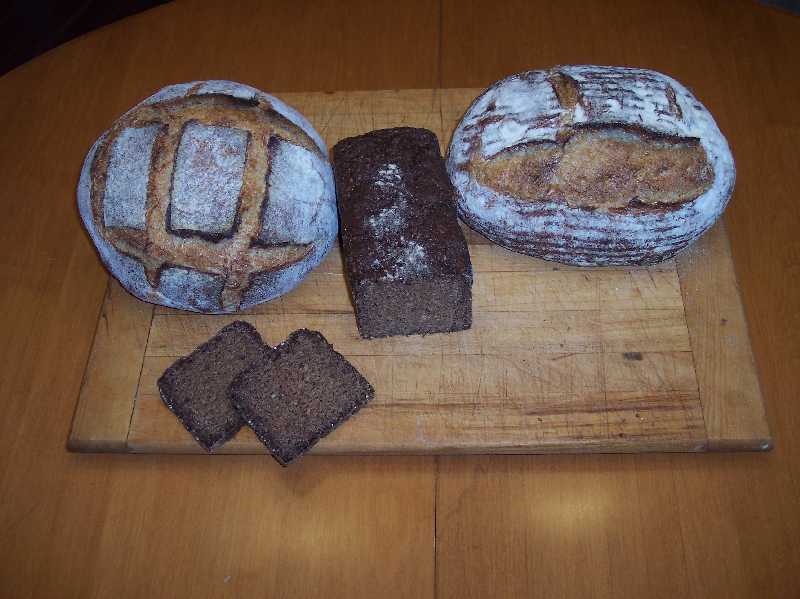
Horst Bandel's Black Pumpernickel from Hamelman's 'Bread' has been on my radar for as long as I've owned the book (about 9 months). The recipe is like no other pumpernickel that I've ever seen before, as all the ones I've come across previously have had caraway in them. I just assumed that it wasn't true pumpernickel if it didn't have caraway, so I've never bothered making it at home, having never acquired a taste for the stuff. When I read the formula for the HB pumpernickel I began to wonder if I'd ever really had a true pumpernickel since this formula and Hamelman's write-up preceding the recipe made it look very authentic to me. One of the other aspects of this bread that intrigued me was the long slow bake time of 12-16 hours. The process of slow cooking has always held a fascination for me through it's use of controlling heat and moisture, as well as smoke in the case of BBQ, to create something that is greater than the sum of it's parts. Anyone who's had the pleasure of eating a Texas style beef brisket or Southern style pulled pork shoulder will know exactly what I'm referring to. Never having baked a bread for much longer than an hour, the HB was something that I needed to try, just for the experience if nothing else. Last week I finally had all the things in place that I needed in order to make it, including the necessary free time. Two of the items had to be ordered such as the Pullman pan and the rye chops, and that took a few weeks, but in the interval I used the time to glean as much information from Andy, Nico, and others posted experiences with this bread as I could.
There are several components to this bread requiring a little preparation in advance, however I'm not going to go into all the detail here since Andy, Nico, Eric Hanner, Tx Farmer and Shiao-Ping have all covered this in their posts far better than I ever could.
http://www.thefreshloaf.com/node/17254/horst-bandel039s-balck-pumpernickel
What I will tell you is that this is without a doubt the stickiest, most cake-like bread dough that I've ever mixed by hand or machine. At one point early on in the hand mixing I wondered if the dough would ever come together enough that I could mold it, but with a little flour correction and some patient but gentle table work I finally managed to get it to a state I was confident it would mold properly after it's bulk fermentation of 30 minutes. Other than that everything went well thankfully, and I put it in the oven for it's overnight bake at 4:00PM, then gradually lowered the oven temp from 375F over the course of the next 5 hrs. Before going to bed I put the pan on a rack placed over an aluminium foil roasting pan and added 2L of boiling water to the roaster and lowered the heat to 170F (as low as the oven goes). Except for a 3AM check of the water level, the loaf went undisturbed until 8:00AM at which point I tested the loaf for excess moisture with a bamboo skewer. The skewer came out dry and the loaf was removed from the oven. By this time the house was filled with the rich aroma of rye and an almost a caramel like scent that even my wife Marie thought was quite wonderful. Remarkable, since she's not a fan of rye bread by any means.
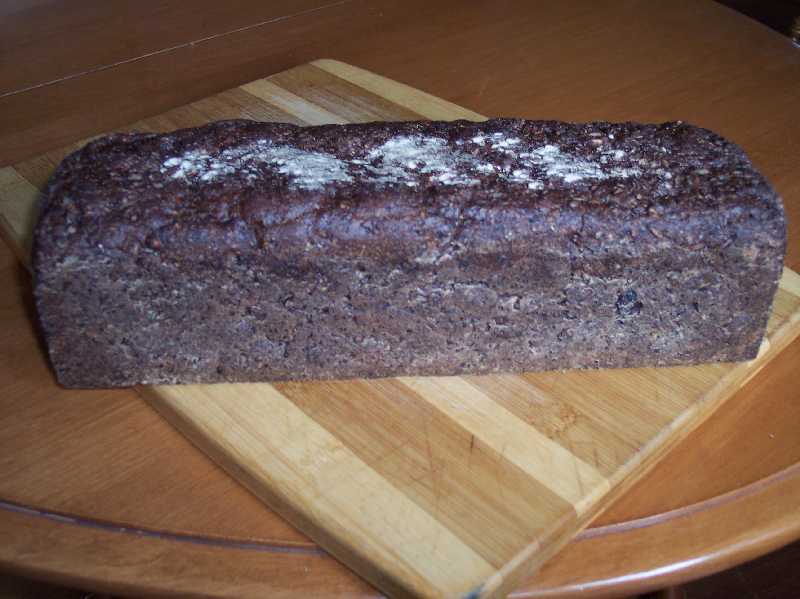
About 12 hours later I gave in and cut off a thin slice to have my first taste of this amazing bread. Trying to describe the flavour of this bread is like trying to describe a full bodied red wine. There's so much going on in it, from sour to sweet, to fruit nuances, overall balance, depth of flavour and finish, etc. It's simply the most flavourful and complex bread I've ever tasted. As for the bake, I think I could have gone with a little less time, as the crust is slightly thicker than I’d prefer, but the crumb is even textured and remains moist even after 5 days. For the most part I'm fairly happy with the result, but knowing that there is considerable room for improvement. I'm happier still with the fact that now I have a better idea of what real pumpernickel should taste like.
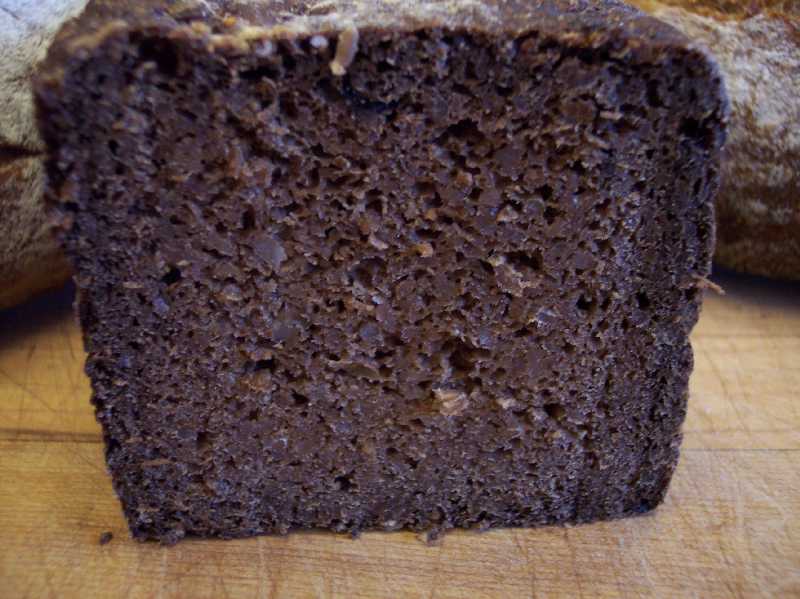
As much as I love the HB Pumpernickel, it's impossible to make a decent size sandwich with it so I used that as an excuse to make the Country Rye Bread from Tartine Bread a few days later. It's really just a Pane de Campagne but with an 81.8% hydration including leaven. Robertson indicates that you can vary the proportion of rye to suit your taste, and as the formula calls for only 17% , I increased it to 20% but keeping the water at the original weight. Other than that the procedure is the same as for his Basic Country Bread that I posted on last week.
http://www.thefreshloaf.com/node/20515/tartine-country-bread-same-dough-two-different-baking-methods
The dough had a cool 70F bulk ferment for 3hrs then placed in the fridge overnight till the next afternoon, (about 19hours). It sat at room temp for an hour, then divided, rounded lightly, and rested for 45 minutes. I shaped one for an oblong brotform and the other as a boule to go in a banneton. The dough was very slack and tacky so I dusted the brotform quite heavily, not wanting any sticking problems on unmolding, which left the finished loaf with a little more flour on it than I would have liked . The oval loaf was baked under a dutch oven, but on the stone as the lid of the dutch oven is concave and wouldn't have worked with this shape of loaf. The boule was baked entirely in the dutch oven. Both loaves turned out quite similar to the Basic Country (BC) loaves, with a nice dark colour and sheen to them. The loaf is quite a bit denser than the BC because of the rye, but with a slightly open crumb, if a little irregular in spots. The dough really needed a warmer bulk ferment during the initial stage, which I'll try to be more careful with next time around. I found this to be a pretty easy dough to make despite it's high hydration simply because you do all the workup on it in the bowl until it's time to divide and shape. Then it's just a matter of using a little flour to keep it from sticking to the counter and your hands. The flavour is very good , even better than previous versions of Pane de Campagne I've made that I thought were quite tasty, and this has a beautiful chewy crust that I prefer to the others.
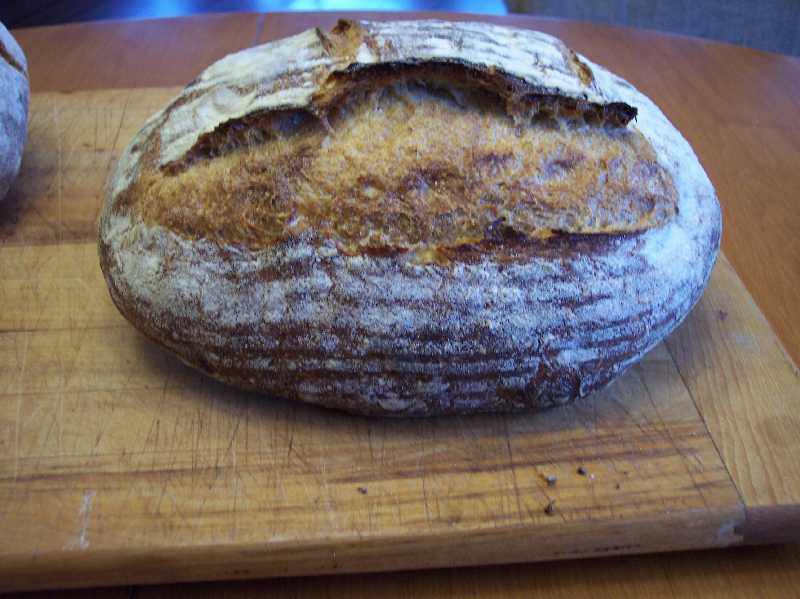
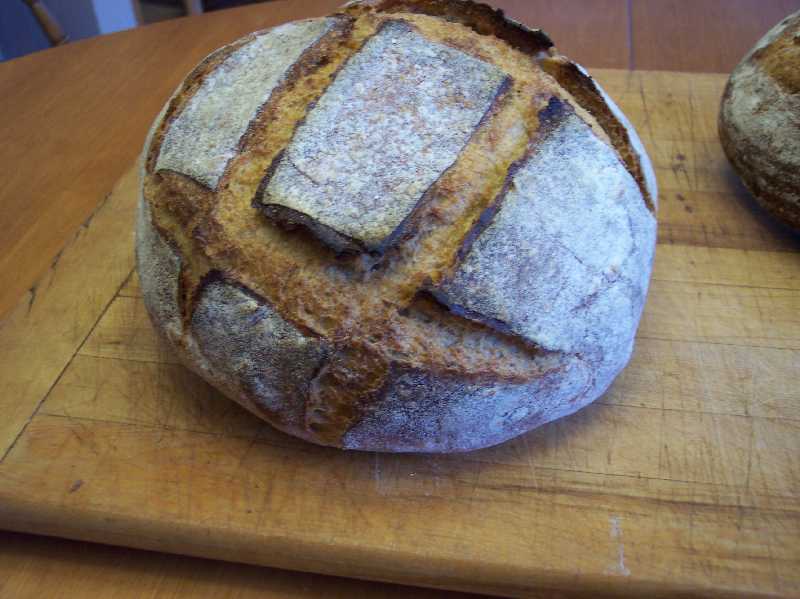
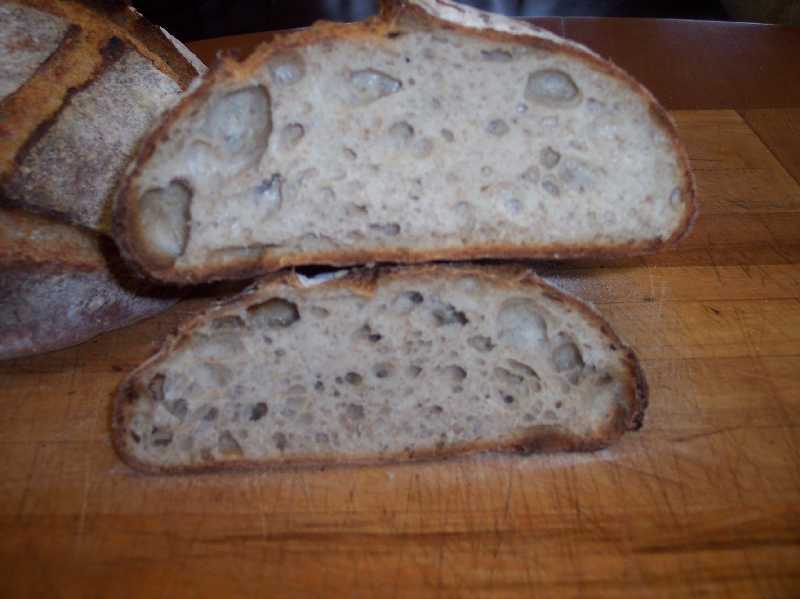
Here on Vancouver Island we're well into storm season, with a cold wet winter fast approaching. Either of these breads will be fine accompaniments with some of my favourite slow simmered stews and braises to help see me through the worst of it.
Best Wishes,
Franko
- Franko's Blog
- Log in or register to post comments
I've yet to venture to try Horst Bandel's Black Pumpernickel, but your loaf looks enticing.
The country rye looks exceptional as well, and reminds me why it's one of my favorites.
Good bake-
Larry
Many Thanks Larry,
It's a real compliment to hear that from a 'rye guy' like yourself.
The HB is a something right up your alley, so I'm sure we'll see your bake of it sometime soon. It's a great test of working with a rye paste, or in this case almost a batter. You made some beautiful rye breads as well Larry. Sorry I haven't actually posted a comment on your blog yet, but I will soon.
Thanks again my friend,
Franko
My pullman pan's on its way! The pumpernickel looks wonderful.
The Country Ryes are gorgeous, too. I like your 2x3 scoring on the boule.
David
Thank you David!
I think we're into 'rye season' don't you? It's funny about the scoring because it wasn't my original intention.The first cut was a little off, leaving me with limited options to use on the fly. Glad you like them, and looking forward to seeing your version of the Horst Bandel.
Franko
Hi Franko,
The boule from the Tartine book looks just amazing. I love to do this type of bread with a rye sour as a leaven, instead of the usual wheat levain.
I'm so glad you made it through to doing the HB; it's a wonderful bread, and though not that technically challenging, does offer up a few difficulties along the way. I don't mold the bread as such. I just use wet hands to transfer the paste to the tin and smooth down. I line the tin with silicone paper to be sure it doesn't stick. Thanks for putting in the reference to my post, that is much appreciated.
Enjoy HB, it will keep for weeks! But I suspect that won't be happening in your house.
Enjoy the Fall, it's turning more wintry over here in the UK now!
All good wishes
Andy
Hi Andy,
Thanks for your comments, much appreciated.
The HB was an interesting bread to do. It had been quite a while since I'd worked with a high ratio rye dough, and it took a bit to get the 'feel' of it again. The molding, if you can call it that, was just forming it into a log as per Hamelman's directions. The pan that I have has a nice new shiny glaze on it, but I did oil and dust it with rye flour before panning the dough. When it was baked it just slid right out of the pan into my hands.
Because I'm able to slice this so thinly I still have about 2/3rds of it left and half of that I'll freeze to save for the Christmas season.
It only seemed proper to reference your post since I used it as my main TFL resource for making the bread, so I was happy to do so. Thanks for sharing your experience.
All the best Andy,
Franko
Hello Franko, Congratulations on your beautiful rye loaves! You and many others are inspiring me - there have been many lovely rye bread posts lately. Regards, breadsong
Hello breadsong and thank you very much!
I think as the weather gets a little cooler for many of us you'll start to see lots of rye breads being posted over the coming months. Looking forward to seeing yours.
ATB,
Franko
That pumpernickel, with or without caraway, is clearly a goal to work towards. I'm not sure I am ready to make a grail of it just yet, with so many other breads in the lineup, but it's definitely on my radar now, as it was originally for you. First, get a pullman pan.
Thanks for the useful post and the photos of the beautiful loaves.
Thanks louie,
A Pullman is what's used in this recipe , but I don't see why you couldn't use a another type as long as you seal it with foil and keep something heavy and flameproof resting on the rim of the pan. On the other hand, having a Pullman pan is good for lots of other types of bread as well. Do give it a try though at some point, you'll love it!
Glad you found this post useful.
Franko
For those that have the book "Bread" by Jeffry Hamelman, there are those who have baked the Horst Bandel and those that are planning on, even dreaming of making it. Hamelman delivers a stirring account of how he came by the recipe and method. It is a very personal telling of a moving story.
After reading your procedure, I would say you present some interesting ideas for making this bread better. I like your water bath idea. In fact you might consider tenting the baking pan with foil to keep the entire pan closer to boiling. The bread look very nice Franko. I think you will find as it sits for a few days the moisture will soften the crust and make it less difficult to eat. I do sometimes remove the very outer crust when making a cream cheese and smoked salmon with capers open faced sandwich. A meal fit for a king!
The country loaf is beautiful as well. Sounds like comfort food weather to me. Nice post Franko. Stay dry.
Eric
Hi Eric,
I wish I could take credit for the water bath idea but I think Andy was the originator of that one. I did actually consider tenting the pan but I was worried that the pan would run dry overnight if the temp got too high, and it would be tricky to get a good enough seal to keep the steam in.
Your right about the crust , it has softened considerably over the last 6 days or so, but what's surprised me even more is how the flavour has improved with age. It tastes better now than it did 4 days ago!
Like you, I've been eating it with smoked salmon as well, but with our locally made hot smoked (alder) version...minus the cream cheese. Great stuff!
It's always good to hear from you Eric, and your compliments are very much appreciated.
Franko
Franko, the HB looks very well done and the other one has a very promising look.
Welcome to the world of intense taste and aroma!
My thanks to you Nico!
My goal was to try and achieve a similar colour to your own fine bakes of this bread. Thanks for the inspiration!
Franko
You certainly have achieved a high standard with your rye loaves. Beautiful scoring also . The weather here in AL is WARM and sunny day after day. We are just getting falling leaves. The rye will be for an outdoor picnic with a sharp cheddar and ripe pears I am thinkin' . No winter in sight here. c
Here on Vancouver Island today we're getting a bit of a sunny break thankfully. Still too cold for my liking but at least it's dry and the wind is less than 30Km/per hr .
Glad you liked the loaves trailrunner and thanks for your comments.
Franko
I can only imagine the taste...your description was fabulous. I made my first Whole Wheat French Rounds (boules?) today. (PR's Brother Juniper's Recipe) I'm waiting for them to cool now. Hoping for holes when cut.
I called my best friend awhile back and asked what her favorite bread was...she has lived in Italy, I was expecting Ciabatta BUT NO she said Pumpernickel. A bread I don't been know how to spell, never mind know what it tastes like. When I ever saw the cooking time I was shocked!
So I'm wondering if I should try the recipe which you made (and do I really need a pullman pan, what about large loaf or is cover required?) And I did bust bead that recipe the other day. I'm wondering if I should try HB's or is too advanced?
Well, congrats on yours can't wait to try my own
~gardenchef (Boston)
Hi,
Thanks for your compliments on the loaves!
A few thoughts about working with high ratio rye breads:
I don't know what your experience is working with these doughs , but if your unfamiliar with them I'd suggest starting with a formula that has a ratio of not more than 20% rye content in it so that you can get used to the feel of the dough. Rye flour doesn't act like wheat flour as it has far less gluten available in it than wheat flour. If you gradually increase the amount of rye over the course of several mixing sessions you'll develop a 'feel' for how it should be handled. Having a copy of Hamelman's 'Bread- A baker's Book of Techniques and Recipes' is probably one of the best books you can have with you as you learn about rye. It's the next best thing to learning hands on from an experienced baker and I highly recommend it.
Hope this has been of some use to you.
Thanks again,
Franko
Ah, that HB loaf reminds me of my own maddening, but delicious, journey with that recipe, you did a great job with it!
The rye country loaf is perfection! It's one of the few formulas I "haven't" tried from the "Tartine Bread Book", now I must tackle that one too!
Congrats on great loaves!
Thanks txfarmer!
Knowing what high standards you set for your own breads and baked goods this is a very nice compliment to receive from you. Many thanks!
The Tartine Rye is wonderful and I'm sure you'll enjoy it. A little sticky, but a walk in the park compared to the HB.
Franko